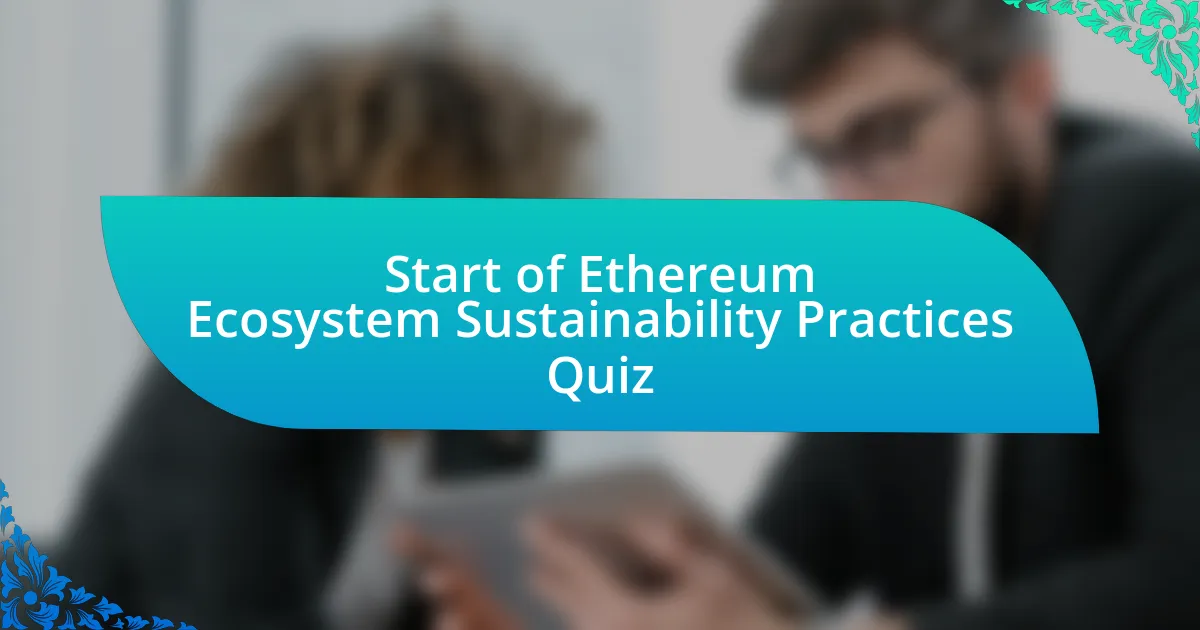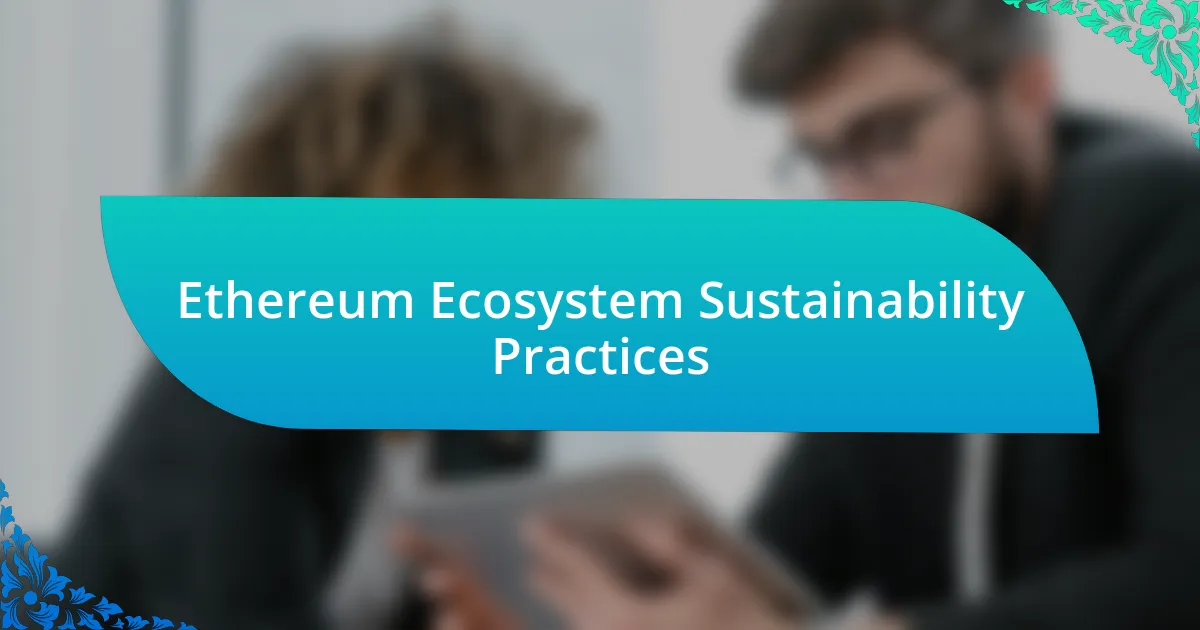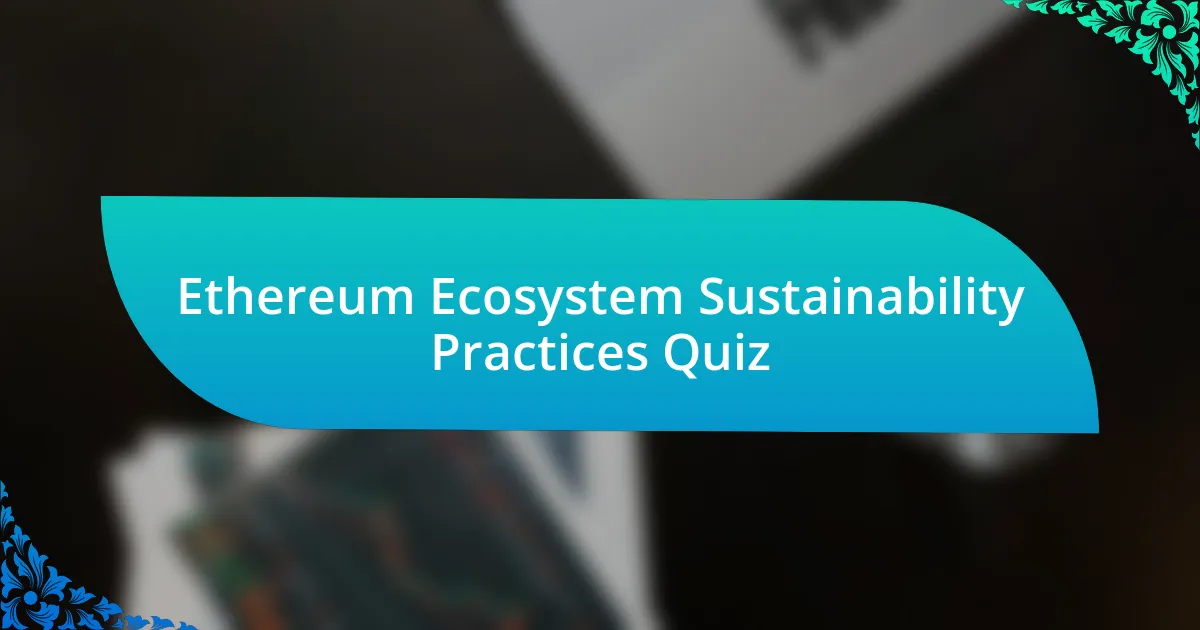
Start of Ethereum Ecosystem Sustainability Practices Quiz
1. What is the primary concern regarding Ethereum`s environmental impact?
- High transaction fees.
- Energy consumption.
- Centralization risks.
- Network congestion.
2. What consensus mechanism does Ethereum currently use?
- Delegated Proof of Stake (DPoS)
- Proof of Work (PoW)
- Proof of Stake (PoS)
- Practical Byzantine Fault Tolerance (PBFT)
3. What consensus mechanism did Ethereum previously use?
- Proof of Work (PoW)
- Delegated Proof of Stake (DPoS)
- Practical Byzantine Fault Tolerance (PBFT)
- Proof of Stake (PoS)
4. How much energy does Ethereum consume annually?
- Approximately 0.0026 TWh/yr.
- About 5 TWh/yr.
- Around 10 TWh/yr.
- Nearly 1 TWh/yr.
5. What is the estimated yearly carbon footprint of Ethereum?
- 300 tonnes CO2e.
- 870 tonnes CO2e.
- 500 tonnes CO2e.
- 1200 tonnes CO2e.
6. What is the purpose of the transition from PoW to PoS?
- To increase transaction speed and scalability.
- To reduce energy consumption and mitigate carbon emissions.
- To eliminate all transaction fees.
- To enhance security and decentralization.
7. How much energy reduction has Ethereum achieved with the transition to PoS?
- Complete elimination of energy use.
- Over 80% reduction in energy use.
- Nearly half of its previous energy consumption.
- Minimal 10% reduction in energy consumption.
8. What is the estimated energy reduction percentage after the transition to PoS?
- 25%.
- Over 99%.
- 75%.
- 50%.
9. What is the role of staking in Ethereum`s PoS mechanism?
- Staking increases mining rewards for all participants.
- Staking solely focuses on improving transaction speed.
- Staking eliminates the need for any transaction fees.
- Wealth is used as collateral in the staking process.
10. How does Ethereum`s PoS mechanism select the next block creator?
- A random participant is selected from the entire network.
- The software randomly selects a `staker` to create the next block.
- The staker with the most tokens creates the next block.
- The oldest staker is chosen to create the next block.
11. What is the result of creating the next block in Ethereum`s PoS mechanism?
- The creator pays a fee.
- The creator receives a reward.
- The creator loses their stake.
- The creator waits for approval.
12. What are layer 2 solutions in Ethereum?
- Layer 2 solutions include Optimistic Rollups and zk-Rollups, which process transactions off the main Ethereum chain.
- Layer 2 solutions increase the transaction fees on the Ethereum network.
- Layer 2 solutions require more energy to process transactions.
- Layer 2 solutions decentralize mining on the Ethereum network.
13. What is the purpose of layer 2 solutions in Ethereum?
- To enhance the liquidity of Ethereum tokens in exchanges.
- To reduce the network`s strain and energy consumption.
- To increase the number of miners participating in transactions.
- To improve the aesthetics of the Ethereum blockchain interface.
14. How does sharding improve Ethereum`s scalability?
- Sharding breaks the blockchain into smaller pieces, allowing different groups of validators to process transactions simultaneously.
- Sharding stops transactions from being processed until the network is less busy.
- Sharding merges all transactions into a single block for efficiency.
- Sharding creates a centralized database for faster access to transactions.
15. What has replaced sharding as the primary scaling solution in Ethereum?
- Token burning
- Side chains
- Layer 2 rollups
- Sharding
16. What is the result of using layer 2 rollups in Ethereum?
- Massive improvements in transaction speeds and costs without losing security and decentralization.
- Higher fees with no change in transaction security.
- Increased energy consumption and slower transaction speeds.
- Decreased decentralization and increased costs for transactions.
17. What is the role of community initiatives in Ethereum`s sustainability efforts?
- Community initiatives discourage collaborations with environmental organizations.
- Community initiatives aim to centralize decision-making in the Ethereum network.
- Community initiatives focus on sustainability and eco-friendly practices within the Ethereum ecosystem.
- Community initiatives promote competitive mining to increase network speed.
18. How does transparency contribute to addressing environmental concerns in Ethereum?
- Transparency allows stakeholders to hide energy usage data to avoid regulation.
- Transparency provides data on energy consumption, carbon emissions, and sustainability initiatives, allowing stakeholders to make informed decisions.
- Transparency distracts from the real issues impacting environmental concerns in Ethereum.
- Transparency keeps the blockchain technology secret, reducing scrutiny from stakeholders.
19. What is the significance of global collaboration in Ethereum`s sustainability efforts?
- Global collaboration encourages competition among blockchain platforms for energy efficiency.
- Global collaboration solely focuses on increasing Ethereum`s market share.
- Global collaboration aims to centralize control over Ethereum`s network decisions.
- Global collaboration involves working with environmental organizations, research institutions, and regulatory bodies to implement innovative solutions.
20. What is the estimated electrical energy consumption of a single Ethereum transaction?
- Equivalent to the energy used by a smartphone in a week.
- Equivalent to the energy consumed by a refrigerator in a month.
- Equivalent to the power consumption of a small electric car for a day.
- Equivalent to the power consumption of an average U.S. household over 0.01 kWh.
21. What is the estimated carbon footprint of a single Ethereum transaction?
- Equivalent to the carbon footprint of 1,000 kg CO2.
- Equivalent to the carbon footprint of 0 kg CO2.
- Equivalent to the carbon footprint of 100 kg CO2.
- Equivalent to the carbon footprint of 500 kg CO2.
22. How does Ethereum`s energy consumption compare to other products and industries?
- Ethereum`s energy consumption is the highest among all digital currencies.
- Ethereum`s energy consumption is relatively low compared to other products and industries.
- Ethereum`s energy consumption is on par with large power plants.
- Ethereum`s energy consumption is significantly higher than most industries.
23. What is the purpose of the Ethereum Energy Consumption Index?
- To track the number of users on the Ethereum platform.
- To analyze the profit margins of Ethereum transactions.
- To provide the latest estimate of the total energy consumption of the Ethereum network.
- To monitor the trading volume of Ethereum tokens.
24. What is the result of comparing Ethereum`s energy consumption to a centralized institution like Mastercard?
- Both systems use energy equally.
- Decentralization always has a price; some argue this feature is worth the cost.
- Mastercard has a lower carbon footprint than Ethereum.
- Ethereum consumes more energy than Mastercard.
25. What is the significance of the `Merge` upgrade in Ethereum`s transition to PoS?
- The `Merge` upgrade increased Ethereum`s mining rewards.
- The `Merge` upgrade doubled Ethereum`s transaction speed.
- The `Merge` upgrade eliminated all transaction fees in Ethereum.
- The `Merge` upgrade significantly reduced Ethereum`s energy consumption by nearly half.
26. What is the estimated annualized electricity consumption of Ethereum before the transition to PoS?
- Approximately 5.0 TWh/yr.
- Approximately 1.5 TWh/yr.
- Approximately 0.0026 TWh/yr.
- Approximately 10 TWh/yr.
27. How does Ethereum`s proof-of-stake mechanism differ from proof-of-work?
- PoW uses random selection, whereas PoS is based on computational power.
- PoS uses wealth as collateral, whereas PoW uses energy-intensive mining devices.
- PoW relies on wealth as collateral, while PoS uses miner rewards.
- PoS generates blocks through energy consumption, while PoW selects validators randomly.
28. What is the role of staking in Ethereum`s sustainability efforts?
- Staking requires the use of specialized mining hardware.
- Staking has no effect on energy consumption.
- Staking increases transaction fees for users.
- Staking reduces the need for energy-intensive mining devices.
29. What are some community-driven initiatives focused on sustainability in Ethereum?
- Exclusive partnerships, restricted access, and reduced awareness.
- Increased mining, higher gas fees, and external funding.
- Educational outreach, transparency, and global collaboration.
- Centralized governance, fixed resource allocation, and minimal reporting.
30. How does Ethereum`s transition to PoS contribute to its sustainability efforts?
- The transition has no effect on energy requirements.
- The transition reduces energy consumption and carbon emissions.
- The transition increases transaction fees and costs.
- The transition relies on energy-intensive mining processes.

Quiz Successfully Completed!
Congratulations on finishing the quiz on Ethereum Ecosystem Sustainability Practices! Engaging with this material has likely deepened your understanding of how Ethereum is striving for sustainability in a rapidly changing digital landscape. You’ve explored crucial topics such as eco-friendly consensus mechanisms, the role of community initiatives, and the impacts of blockchain technology on our environment.
Throughout the quiz, you may have discovered the significance of responsible development and energy-efficient practices within the Ethereum network. These insights highlight the importance of sustainability in the tech industry, as well as the ongoing efforts to minimize the carbon footprint of blockchain technology. The questions not only tested your knowledge but also encouraged you to think critically about the intersection between technology and environmental responsibility.
We invite you to dive deeper into the subject by checking out the next section on this page. There, you will find in-depth information about Ethereum’s sustainability practices and broader initiatives. Expanding your knowledge in this area can empower you to be part of the dialogue surrounding sustainable blockchain development. Thank you for participating, and we hope you find the continued learning enriching!

Ethereum Ecosystem Sustainability Practices
Overview of the Ethereum Ecosystem
The Ethereum ecosystem is a decentralized platform built on blockchain technology. It allows developers to create and deploy smart contracts and decentralized applications (dApps). Ethereum’s unique feature is its use of Ether (ETH) as the native cryptocurrency to facilitate transactions. Over time, the ecosystem has expanded to include various projects, protocols, and services that contribute to its robust functionality.
Environmental Impact of Ethereum
The environmental impact of Ethereum largely revolves around its energy consumption. Initially, Ethereum operated on a proof-of-work (PoW) consensus mechanism, which required significant computational power and energy. This raised concerns regarding carbon emissions and sustainability. In 2022, Ethereum transitioned to proof-of-stake (PoS), which drastically reduced its energy use by up to 99.95%, significantly lessening its carbon footprint.
Sustainable Development Initiatives in Ethereum
The Ethereum community actively promotes sustainable development initiatives. Projects focus on minimizing environmental impact while maintaining network efficiency. These initiatives include innovations in energy-efficient computing and carbon offset programs. Additionally, organizations, such as the Ethereum Foundation, invest in research and development aimed at improving sustainability practices within the ecosystem.
Community Involvement in Sustainability Practices
Community involvement plays a vital role in enhancing sustainability practices in the Ethereum ecosystem. Developers, miners, and users collaborate on solutions to reduce energy usage and improve the environmental footprint. Grassroots organizations raise awareness and promote best practices for eco-friendly development. Regular discussions and proposals via Ethereum Improvement Proposals (EIPs) encourage ongoing community contribution to sustainability efforts.
Future Directions for Sustainability in Ethereum
The future of sustainability in the Ethereum ecosystem centers on continued innovation and adaptation. Upcoming updates focus on improving scalability and energy efficiency without compromising security. Projects exploring layer-2 solutions may further enhance transaction speed while reducing environmental impact. Collaborative efforts across the blockchain community aim to establish Ethereum as a leader in sustainable technology practices.
What are Ethereum’s sustainability practices?
Ethereum’s sustainability practices primarily involve the transition from a proof-of-work (PoW) consensus mechanism to a proof-of-stake (PoS) model. This shift significantly reduces energy consumption by over 99%, as PoS requires validators to hold and lock Ether instead of using energy-intensive mining processes. The Ethereum Foundation has actively promoted these practices through educational campaigns and incentives for developers to create energy-efficient applications.
How does Ethereum aim to reduce its carbon footprint?
Ethereum aims to reduce its carbon footprint by implementing the proof-of-stake mechanism, which minimizes energy usage compared to its previous proof-of-work system. This change aligns with global sustainability goals, as PoS eliminates the need for high electricity consumption associated with mining. Additionally, Ethereum’s roadmap includes partnerships and initiatives aimed at offsetting emissions and promoting renewable energy usage within its ecosystem.
Where can users find information about Ethereum’s sustainability efforts?
Users can find information about Ethereum’s sustainability efforts on the official Ethereum website and the Ethereum Foundation’s blog. These resources provide updates on the transition to proof-of-stake, environmental impact assessments, and initiatives aimed at promoting sustainability within the ecosystem. Community forums and social media channels also share insights and developments related to these practices.
When did Ethereum transition to proof-of-stake?
Ethereum transitioned to proof-of-stake on September 15, 2022, during an event known as “The Merge.” This milestone marked the end of proof-of-work operations and initiated a new era of energy efficiency, drastically reducing Ethereum’s energy consumption and carbon emissions. The transition was a critical step toward achieving sustainability within the Ethereum ecosystem.
Who benefits from Ethereum’s sustainability initiatives?
Ethereum’s sustainability initiatives benefit a wide range of stakeholders, including developers, users, and the broader community. Developers can create more energy-efficient applications, attracting environmentally conscious users. Additionally, the reduction in energy consumption aids in broader climate goals, benefiting society and the environment. Investors also benefit from the potential for increased regulatory support due to Ethereum’s commitment to sustainability, which can enhance the network’s legitimacy and value.

